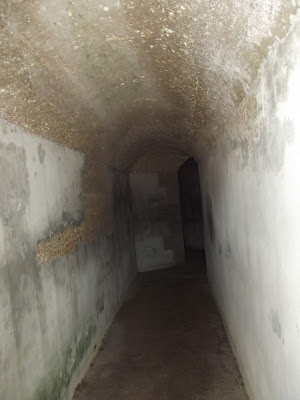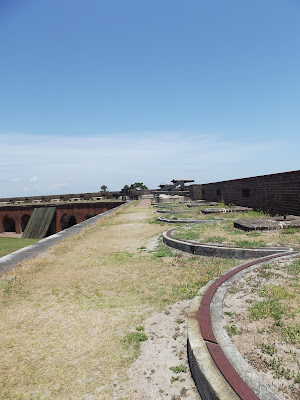With
temperatures in the upper 90s feeling like over 100 we are looking for
something that doesn’t require a lot of walking outside. We read about the bee garden tours at the
Savannah Bee Company and tried to book a time online with no success. We are hoping we can talk our way into a tour
when we show up.
Greg picked
Molly McGuires for lunch. We had trouble
finding this place and once we found it a semi had an accident and was blocking
the drive – no problem we have a Jeep, a little off road and we were there.
The entrance
is interesting.
With all of
the shade we opted for outside seating.
Someone was
waiting for crumbs.
Thank
goodness this guy wasn’t real.
We couldn’t
decide so we had a variety of appetizers, crab dip, southwest egg rolls and pot
stickers.
Here we are
at the Savannah Bee Company
They have 3
or 4 sites but we chose this one because they have tours. Our power of persuasion wasn’t going to get
us a tour today. Everyone but the one
clerk in the store was at a beekeeper’s convention.
A working
hive is on display in the showroom.
Who knew
there were so many different kinds of honey?
The tasting is free and the clerk reminded us to taste slowly and give
it some time between tastes so they don’t all end up tasting alike.
They have
honey based cleansers, shampoo and creams and bee smokers (on the top shelf) if
you find you need one of those.
Lots of
honey for purchase.
Our purchase
for the day, some orange blossom honey and lip balm.
The drive to
Tybee Island, I love these trees with moss.
We stopped
at the North Beach Bar and Grill for lunch.
North Beach was incorporated in 1887.
The grilled
fish taco was great.
Greg opted
for a shrimp po’boy. We shared the sweet
potato fries which was drizzled with a balsamic vinegar reduction, different
but good.
The
boardwalk to the beach.
The beach is
crowded today, the last time we were here it was in the fall and rainy so we
almost had the beach to ourselves. It
was really hot out today so we didn’t stay long.
I still
couldn’t convince Greg to climb to the top of the lighthouse.
We had to
laugh because there is a sign that says the Battery Brumby is a “Severe Weather
Safe Site” but all of the doors appear to be padlocked shut.
Greg
wondered how long it would take a turtle to get across the road.
Ft. Pulaski
is named for a Polish soldier who fought for Polish liberty against
Russia. When Poland lost he was forced
to flee his homeland. He met Benjamin
Franklin in Paris in 1777 and Franklin inspired him to join America’s fight for
freedom. In 1778 Congress selected him
to command the newly formed cavalry unit and he became known as the “Father of
the American Cavalry”. He was fatally
wounded in 1779 during the Battle of Savannah.
Construction
of the fort began in 1829, long before the War Between the States was to
begin. Robert E. Lee, fresh out of West
Point, took his first assignment as assistant engineer on the project. The marshy ground on Cockspur Island had to
be prepared for the heavy fort. Lee
conducted surveys, selected the exact site for the fort and began building the
drainage and dike systems.
The view of
the fort from the parking lot. This is a
national memorial so our senior pass got us in for free.
Crossing the moat into the fort. The moat is 7’ deep and is home to the
occasional alligator.
This is a
passageway to the gun placements outside the fort. I was just glad there were no bats inside.
Massive
doors were part of the defense of the fort.
The fort is
built around this large grassy parade ground.
The breezes
through these covered walkways was amazing on this very hot day.
Ten cisterns
like this one stored 200,000 gallons of water.
Rain water came in through a series of pipes. After the capture of the fort in 1862 Union
soldiers supplemented the natural supply with a steam condenser which converted
the moat’s salt water into fresh.
Col.
Olmstead surrendered in this room on April 11, 1862.
Even though
these cannons were built with a track so they could be moved, that had to be a
major undertaking.
Thirty-one
steep steps up a spiral stairway with no hand rail and you are on the top
level.
Room for
more cannons up here. The fort was
designed for 140 cannons.
On April 10,
1862, Confederates refused a demand to surrender because the enemy guns were a
mile away on Tybee Island – more than twice the range of heavy artillery of the
day. However, the Union troops had new
“rifled” cannons. When they fired those
spinning projectiles, they bored through the brick walls of the fort especially
those in the area containing 40,000# of gun powder. In less than 30 hours the Confederates were
worried about being blown up by their own gun powder among other things. They considered the situation hopeless and
surrendered.
Inside the
fort from above.
Cannons
could have lined the walls.
It took 25
million bricks to build the fort.
Fingerprints of those who made the bricks can still be seen.
Confederate
soldiers prepared for battle using earth and timbers to create a “bindage” to
protect troops from incoming shells.
They also dug ditches in the parade ground to catch rolling cannon shot
(I thought this was genius).
The
commanding officer’s quarters.
The Federal
medical dispensary.
It was hard
to get a picture of this bird, I think it is a brown pelican. Lots of these birds were diving into the
water and catching fish for lunch. Quite
the spectacle, but hard to catch on film, I need to get comfortable with
videos.
More trees
with moss on the way home.
This tour
was Greg’s suggestion and I am so glad he made it, what an interesting
place. If you get the chance to go,
definitely opt for the 90 minute tour rather than the 30 minute one.
We had to
wait a bit for our tour time so we walked down the Daytona 500 Champions Walk
of Fame.
Our favorite
drivers have been winners.
This place
is huge.
This
“Daletona” mosaic artwork made up of very small pictures commemorates the
career of Dale Earnhardt, Jr.
We killed a
bit more time in the gift shop.
The tour is
about to begin.
These
tunnels are original to the track. At
the time the track was built the drivers drove their cars through these
tunnels, there were no semi-truck haulers to move them in.
We weren’t
able to get out on the track today because of some testing being done. The 31
degree banking is a little hard to appreciate from this angle.
During the
races, personnel occupy the Sunoco tower looking for debris or problems on the
track.
These are
the current tunnels that will accommodate the semis and RVs.
You have to
be really far back to get all of the grandstand seating in one picture.
The black
and white seats are prime seating. From
them you can see not only the race but the victory lane celebrations as well.
The
multicolored seating makes it look like the area is filled even if it’s not.
We made a
“get out of the trolley” stop at Fan Zone.
The
University of Northwestern Ohio sponsors the Fan Zone. I found that odd until they mentioned that
the university has a high performance motorsports technology curriculum.
The blue
garages are for the Xfinity cars.
We also
spent some time in Victory Lane.
The green
seats in Victory Lane are for the members of the press.
If you
belong to the Daytona 500 Club which is in special rooms above Victory Lane
your food and drinks are included in the price of your ticket. Our tour guide dodged a lot of questions
about the cost – he wouldn’t say, but I think it is a safe bet that we won’t
ever be there.
Since the
Daytona 500 Club is above Victory Lane they don’t really have a very good view
of the happenings in the lane so special seating is provided for them.
We are
headed into the Media room.
There is
assigned seating when the big day arrives.
All the
connections they need are at every station.
This is the
stage and table where the winners are interviewed after the race.
Just think,
the next winner will be thinking, “this is where Greg and Diana Jones sat”.
This is the
RV park for the owners and drivers.
There is a separate area for race attendees’ RVs.
The blue car is the reason we couldn’t get on the track today.
There are 3
solar panel covered rest areas around the facility providing electricity for
the complex.
We are 13
stories high in the black and white seats looking toward Victory Lane.
Fan Zone
from the black and white seats. The
large metal structure holds the jumbotron screen. When it isn’t in use it is taken down for
safety.
The yellow
garages are for the Cup Series cars.
The airport
in the background makes getting to the race very convenient for those who fly
in their own plane or a charter flight.
The flag
stand and finish line down below. Note
that the grass doesn’t look like it does for the Daytona 500. Some motocross events have dirt brought in
which covers the grass. When it is
hauled out, the grass is reseeded and will be ready for the next race.
The finish
line continues outside the building.
Denny
Hamlin’s 2019 winning car just as it came off of Victory Lane.
I tried the
31 degree of banking exhibit. I couldn’t
walk up it. We saw some pictures of the
track being built that showed the machinery working on the track having to be
cabled to machinery on level ground up above to keep them from sliding down the
track.
The Daytona
500 trophy, a smaller replica goes to the winning driver each year.
Entering the
Motorsports Hall of Fame Museum.
In 1935 the
Campbell-Railton “Blue Bird” set a record on the sand in Daytona Beach at
276.82 mph. Later that year Campbell
became the first to exceed 300 mph on wheels at the Bonneville Salt Flats.
I’m a fan of
the movie “Cars”, so I was happy to see the Hudson Hornet.
Micky
Thompson brought the “Challenger II” to the Bonneville Salt Flats in 1968 to
pursue the land speed record for piston-powered cars. The Salt Flats were flooded so he went home
without making a run. The car sat for 42
years until his son Danny restored it and made attempts to set the record. He finally made it in 2018 with a new world
record of 448.757 mph.
Lots of
special cars on display.
Our family
and friends from Indiana might recognize this Pay Less Super Market car.




























































































